Do Buds Change Length at Fourteen Day Intervals?
From experience it is found more important to ensure constant conditions for day to day measurement of a bud than to attempt to set those conditions with perfect precision. In any case, we are more interested in the variations of the bud's parameters than we are in their precise values. Thus, when it comes to placing the lower of the two poles, the "policy" is to find a reasonable (sufficiently accurate) place for it on the first one or two of a series of bud-images and to note its distance from the top pole. This distance is then used to similarly place the lower pole on the remaining images in the series.
This fixed-distance procedure was followed on a series of images of an Oak bud, called "D," photographed by John Blackwood in Sydney, Australia. At a certain stage (as may be seen from the graph), the λ ran down rather abruptly to about two thirds of its value to that point and then, after a time, about twice as abruptly back to the former high values and beyond.
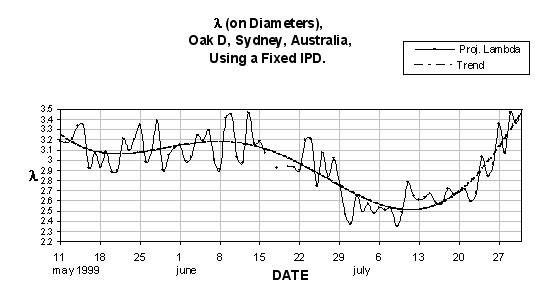
This suggested that the placing of the lower pole was in need of adjustment.
Now, the measurement and analysis of these Oak images were being done with the help of a computer program. A feature of it allows an adjustable "Trial Path Curve" (TPC) to be placed on the bud image. Thus one may obtain, "by eye" so to say, a first approximation to the bud's path curve. This significantly improves the precision with which a pole may be placed. One might say that, using this technique, pole placement is guided, at least approximately, by the path curve nature of the bud's profile, so there is accordingly some justification for calling the Inter-Pole Distance (IPD) so obtained the "path length" of the bud.
By this means, the path length of each bud-image in the entire Oak D series was found, originally with the intention of finding the trend against which the low pole position should be adjusted as the series was worked through. (The bud images were to be re-measured after the adjustments corresponding to the trend had been made.) It was expected that the IPD chart prepared from this set of IPD's would exhibit a slow change with time, most probably a steadily rising value corresponding to a simple growth in size of the bud.
However, it did not. The IPD chart is given below.
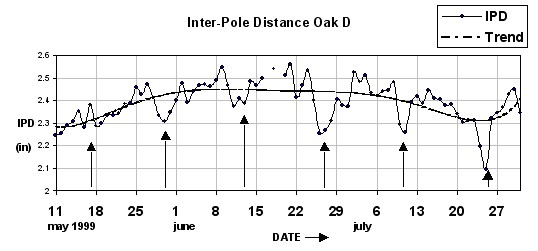
It will be seen that a curve with a generally convex-upwards gesture (except near the end) was obtained, indicating that, seen from a path curve point of view, the bud elongated, reached a maximum length and then reduced in length. This was rather unexpected. Even more unexpected—coming, in fact, as a complete surprise—were the well-defined, temporary contractions of the bud's path length. These show on the chart as "dips" superimposed on the general curve.
As may be judged from the "ruler" of arrows placed on the chart, these contractions occurred at intervals of almost exactly 14 days. By that ruler, only one dip, the first, is missing from this particular chart.
It is far too early to say whether or not a definite and general phenomenon has been discovered—that is, not one confined just to this bud. This one series from a single Oak bud certainly does not supply a proof of generality. Other series of Oaks, and series from other species, will need to be reviewed for the presence of such contractions.
The chart of λ values (shown below) corresponding to the pole positions indicated by the IPD chart follows the latter apparently only in the sense that the λ values generally decrease as the IPD values increase, and vice versa. However, this is found generally: artificially moving the low pole up a bud of constant shape almost always increases its apparent λ, while moving it down almost always decreases it. (There is usually a position for which the accuracy of the path fit is at its best, of course.) It is possible that a natural variation in the bud's length has a similar effect on its λ, whatever the accuracy of that λ may be. This is a matter for investigation.
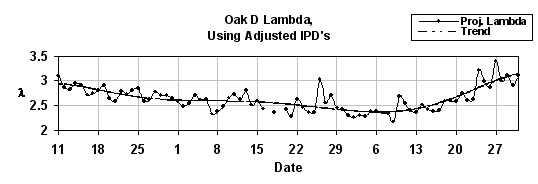
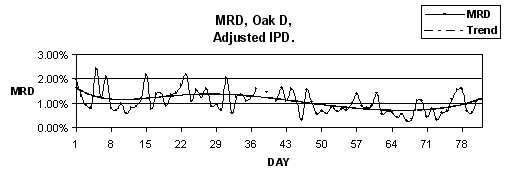
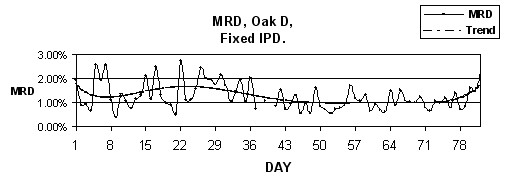
As might be expected, adjusting the IPD's appears to reduce the general MRD, and also the range of its variation.
It must be remarked that a subjective element is present. The Trial Path Curves upon which the placing of the lower poles directly relies are put on the buds by eye. It would be good to have this exercise performed by more than one person, with each unaware of results obtained by the others.Further work is needed.
Graham Calderwood October, 1999.